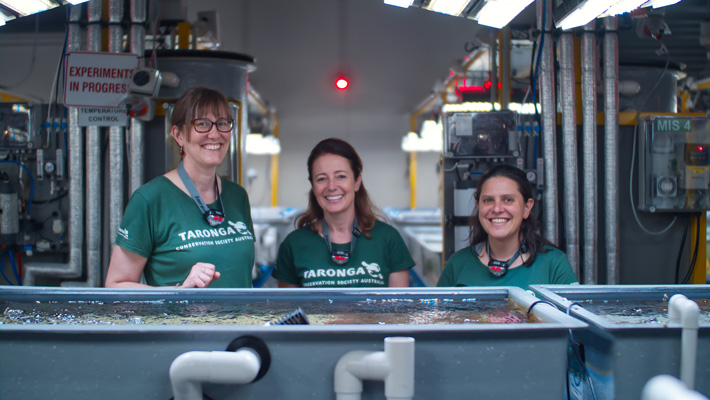Taronga’s top scientists are working to save the Great Barrier Reef by safeguarding its genetic diversity and health.
Taronga is freezing the future of the world's largest coral reef system, the Great Barrier Reef, located in the Coral Sea off the coast of Queensland. The Reef Recovery Program involves cryopreserving cells of reef-building coral species from the yearly spawning event. Precious samples of sperm and other cells are stored in the world’s largest frozen repository of living coral at Taronga’s CryoDiversity Banks at both Taronga Western Plains Zoo Dubbo and Taronga Zoo Sydney.
The annual spawning event sees collaborators and scientists converge at the National Sea Simulator, a world-class marine research facility operated by the Australian Institute of Marine Science (AIMS), located near Townsville. The National Sea Simulator provides a stable platform of water quality, temperature and light exposure, which allows the coral to release their egg and sperm bundles in the same way and timing as would happen in nature. “Following this year’s spawning event the Taronga CryoDiversity Bank Great Barrier Reef collection now includes cells from 26 species of coral and is the largest frozen repository of living coral in the world,” says Dr Rebecca Hobbs, an experienced reproductive biologist at Taronga. “Over the six spawning nights last November, our team banked samples from 79 individual colonies of 15 different coral species, with five new species being added to the CryoDiversity Bank this year. As with plant seed banks, our CryoDiversity Bank represents an invaluable living vault. We can thaw out cells decades, or even centuries, from now to produce living coral offspring. Providing that a healthy habitat exists, these offspring can bolster the genetic diversity of priority coral populations and help ensure their long-term survival.”
Did you know?
The Great Barrier Reef is comprised of 2,900 individual reefs and 900 islands stretching for over 2,300 kilometres across an area of approximately344,400 square kilometres.
Genetic diversity
The Great Barrier Reef and other reef systems are under threat from a variety of environmental factors driven primarily by impacts of climate change. To ensure that reef systems have the opportunity to thrive into the future and recover from the devastating impacts of coral bleaching events like the ones seen in 2016 and 2017, genetic diversity is the linchpin. Cryopreservation can secure genetic diversity and represents one approach to avoiding some of the genetic loss that is occurring in the Great Barrier Reef. “Cryo-repositories of living coral cells and tissues are such an important biological resource for scientists and conservation managers. Taronga’s CryoDiversity Bank is allowing us to learn more about coral biology and provide genetically diverse coral cells for use in preservation and repair of the Great Barrier Reef,” says Dr Justine O’Brien, Taronga’s Manager of Conservation Science.
